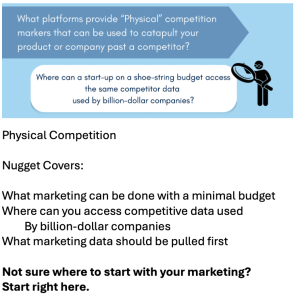Its Physically in the Way
$23.00
Should be added to all core marketing curriculum.
Often times our greatest competition is not even in our industry. This nugget covers a handful of places that competition can be found that has nothing to do with your product or service.
This can sometimes come up during a S.W.O.T. analysis, but more often then not, this area of competition is not discussed. No marketer can ignore these competitors, often referred to as SLEEPING GIANTS.
A TRUE marketer’s treasure.

Should be added to all core marketing curriculum.
Often times our greatest competition is not even in our industry. This nugget covers a handful of places that competition can be found that has nothing to do with your product or service.
This can sometimes come up during a S.W.O.T. analysis, but more often then not, this area of competition is not discussed. No marketer can ignore these competitors, often referred to as SLEEPING GIANTS.
A TRUE marketer’s treasure.
(0:00 – 0:23)
It’s suffocating in the fact that not understanding that there’s three types of competition, how to work with them, how to work outside of them, it’s challenging. This topic hurts so many businesses to discussing the ins and outs of competition, specifically the three types. What are they? How to recognize them and what to do about them.
(0:23 – 0:39)
Whether we recognize them or not, these three, I guess, forms of competition are battling and hurting every entrepreneur and business owner from day one. Let’s begin. We’ve got entropic competition.
(0:39 – 0:46)
I covered that. This one is physical competition and present competition. I’ll explain in a second.
(0:46 – 1:14)
Just the highlight there is entropic competition is the reality that life and business naturally erodes life and business. I explained the law of entropy, how it’s constantly at work against us. I’m not going to go through that again, but I provided some, what I think pretty phenomenal examples how I think there’s a case to be made that the greatest business growth killer could possibly be self-sabotage.
(1:14 – 1:33)
This is dedicated to the type of competition that the world normally associates with that word. The physical competition, meaning if you own, say, a shoe company, you probably view your competition as other shoe companies. These are the people that, you know, if you go to a trade show, they’re in the booth right next door.
(1:33 – 1:42)
They’re the marketplace competitor. And I’m not. So Friday, we’re going to talk present competition.
(1:42 – 2:15)
Present competition, just as a highlight, one sentence is you would describe present competition as the forces that are present during and after your products buying cycle. Let me see if I can say it again. Present competition are the forces or the distractions that are in the way and present during your products buying cycle.
(2:15 – 2:40)
Sometimes it’s been said that your biggest competitor is not the business next door per say down the street that sells shoes. If you’re a shoe company, sometimes your competitor is maybe the video store right next door to you that has a huge electric neon sign and the say 100,000 people driving by every day. They never even see your little shoe company, but they certainly notice the video store.
(2:40 – 3:05)
I would say no question in that scenario, that shoe company’s competitor is the video store next door. It’s competing for all the potential river of money eyeballs out front that are seeing the video store and not seeing the shoe company. So tomorrow, I’m sorry, Friday, I’m going to be talking about that type of competition.
(3:05 – 3:11)
Here we go. Let’s talk physical competition. I remember a day a couple of years ago, I called my attorney.
(3:12 – 3:20)
Here’s how it went. I’m very excited to share this. I have not shared this piece of the story before, but this is kind of cool.
(3:20 – 3:25)
I called Mike, his name is Mike. And I said, Mike, I can’t believe it. I am a sucker.
(3:26 – 3:36)
We had a couple guys call in pretending to be interested in partnering. They were talking some pretty decent numbers. I really wanted to kind of do whatever it took to get these guys on board.
(3:36 – 3:57)
Sure enough, I went ahead and even showed them our tax returns, which I will never do again, thinking it would give them an idea as to how our company was structured. So they feel safe doing, you know, a serious amount of business with this and, you know, learning lesson. But Mike says, ‘I’m confused.’
(3:58 – 4:14)
‘Why are you calling me?’


